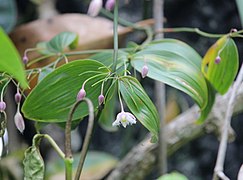| Eustrephus | |
|---|---|

| |
| Flowers | |
| Conservation status | |
| Least Concern (NCA) | |
| Scientific classification | |
| Kingdom: | Plantae |
| Clade: | Tracheophytes |
| Clade: | Angiosperms |
| Clade: | Monocots |
| Order: | Asparagales |
| Family: | Asparagaceae |
| Subfamily: | Lomandroideae |
| Genus: | Eustrephus R.Br. |
| Species: | E. latifolius |
| Binomial name | |
| Eustrephus latifolius R.Br. | |
Eustrephus is a monotypic genus (i.e. a genus that contains a single species) in the family Asparagaceae, subfamily Lomandroideae. The sole species is Eustrephus latifolius, commonly known as wombat berry. It is an evergreen vine native to Malesia, the Pacific Islands and eastern Australia. It grows in sclerophyll forest, woodland, heathlands, shrublands, gallery forest and rainforests.
The leaves are highly variable in shape, elliptic to linear, 30–100 mm (1.2–3.9 in) long and 3–35 mm (0.12–1.38 in) wide. All leaf veins are equally distinct. Flowers are pink to mauve or white. The yellow-orange, globose, capsules are 1–2 cm (0.4–0.8 in) diameter and contain numerous black seeds partly enclosed in a white aril. The variation in the shapes of the leaves has resulted in the creation of numerous infraspecific taxa over the years, none of which are recognised by most present-day systematists.
Uses
The tubers are eaten baked, and have an earthy sweet flavour.
The 1889 book 'The Useful Native Plants of Australia’ records that Eustrephus latifolius is a "climber produces sweet though only small tubers, which, however, are probably capable of enlargement through culture (Mueller)."
Gallery
-
 Foliage and fruit
Foliage and fruit
-
 Flowers, and very broad leaves
Flowers, and very broad leaves
-
 Plant with long narrow leaves
Plant with long narrow leaves
-
 Fruit: black seed in white aril
Fruit: black seed in white aril
References
- "Species profile—Eustrephus latifolius". Queensland Department of Environment and Science. Queensland Government. 2022. Retrieved 31 January 2024.
- ^ "Eustrephus%". Australian Plant Name Index (APNI), Integrated Botanical Information System (IBIS) database (listing by % wildcard matching of all taxa relevant to Australia). Centre for Plant Biodiversity Research, Australian Government. Retrieved 11 December 2013.
- ^ Laferrière, Joseph E. (1995). "Nomenclature and type specimens in Eustrephus R.Br. and Geitonoplesium Hook. (Geitonoplesiaceae)". Austrobaileya. 4 (3): 391–399. JSTOR 41738875.
- Chase, M. W.; Reveal, J. L. & Fay, M. F. (2009). "A subfamilial classification for the expanded asparagalean families Amaryllidaceae, Asparagaceae and Xanthorrhoeaceae". Botanical Journal of the Linnean Society. 161 (2): 132–136. doi:10.1111/j.1095-8339.2009.00999.x.
- F.A.Zich; B.Hyland; T.Whiffen; R.A.Kerrigan. "Eustrephus latifolius". Australian Tropical Rainforest Plants (RFK8). Centre for Plant Biodiversity Research, Australian Government. Retrieved 27 May 2021.
- ^ Harden, Gwen J. (2001). "Eustrephus latifolius R.Br. ex Ker Gawl. – New South Wales Flora Online". PlantNET – The Plant Information Network System. 2.0. Sydney, Australia: The Royal Botanic Gardens and Domain Trust. Retrieved 11 December 2013.
- Low, Tim (1991). Wild food plants of Australia (revised ed.). North Ryde, N.S.W.: Angus & Robertson. ISBN 9780207169304.
- J. H. Maiden (1889). The useful native plants of Australia : Including Tasmania. Turner and Henderson, Sydney.
This Asparagaceae article is a stub. You can help Misplaced Pages by expanding it. |
This Australian plant article is a stub. You can help Misplaced Pages by expanding it. |